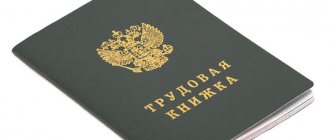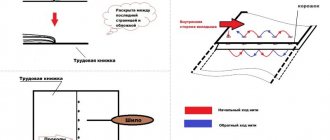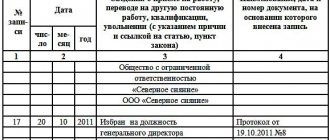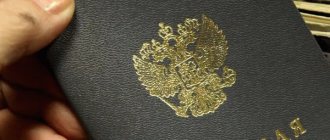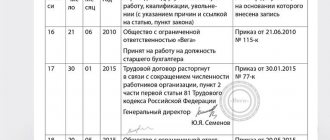Home / Labor Law / Labor book
Back
Published: 06/20/2018
Reading time: 5 min
2
448
Work books belong to strict reporting forms. Current legislation obliges all legal entities and entrepreneurs to maintain them. The document records the periods of work of the owner of the work book.
- Series and numbers
- How to check a document by series and number
- Validity
Series and number of TC
Each genuine work document, printed at Goznak and transferred through intermediaries to the employer, has identification numbers that allow it to be distinguished from others. Almost immediately after the form is produced, identifiers establish strict control over it and accompany it all the way to the owner:
- As a result of the production of forms at Goznak, where series and numbers are controlled during production.
- When transferring work forms and inserts to an intermediary by proxy, where the list contains the identifiers of each form.
- When purchasing forms by the employer, during which the identifiers are also reflected in the list in the act of their acquisition and in the power of attorney under which they are acquired.
- When entering forms into the accounting book, which is stored in the accounting department, as well as in the application, according to which the authorized person receives the TC form and their inserts.
An already completed book, which has become the property of the owner, can always be identified in the following cases:
- loss (read what to do if you lost your book - here);
- theft;
- fakes.
It can be identified by series and number, and its entire path along the chain of movement to the owner can be traced. These circumstances may be important when restoring the Labor Code or during legal proceedings, as well as in other cases that cannot always be foreseen.
When applying for a new place of work, the owner’s work book is registered in the labor register, where its series and number are also reflected. That is, practically no legal action is carried out without indicating the unique number and series of the book.
In essence, the identifier is the face of the book, as well as the citizen’s personal data entered into it.
Identification numbers and series are entered into the TC in a specific way:
- In old books they are written in red paint and written on 10 pages: 1,5,9,13,17,21,25,29,33,37, repeating exactly.
- In the new ones - on 11 pages: 1,3,9,15,19,23,27,31,33,37,39. Their series are made in black paint, and the numbers are red.
Series and years - relationship
The first documents of this form of accounting for experience had neither numbers nor series. They were verified by signatures and seals, date of issue and compared with the originals. However, this labor-intensive process sometimes failed due to the loss of archives. There was another problem. Sometimes it was impossible to determine which authority or enterprise affixed the seals, and whether they exactly corresponded to the originals, as well as the signatures.
There are various work books in the TK series. For example, the first series was released in 1975-1976. Series TK - VIII is an all-Russian series produced until the end of the millennium - 2000.
Distribution by series allows you to quickly find out when the book was published and compare the data entered into it with real information. An approximate diagram of this information by series and dates of use is given in the table.
| Type of book series | Dates when they could be completed and used |
| Modern Russian TK series | |
| V | Modern (since 2015) |
| IV | From 2013 to 2015 |
| III | 2012-2010 |
| II | 2008-2010 |
| I | 2006-2007 |
| TK | 2004-2005 |
| "Soviet" AT series | |
| X | Second floor. 2003 |
| IX | 2001-2003 |
| VIII | 1998-2000 |
| VII | 1993-1997 |
| VI | 1990-1992 |
| V | 1986-1989 |
| IV | 1983-1985 |
| III | 1980-1982 |
| II | 1977-1979 |
| I | 1975-1976 |
As you can see, new books are issued under series number 5 (all series are marked with Roman numerals). No. 3 in the TK series was used until 2012 and became the second series where it was possible to use a holographic protective element.
You can place a holographic element on any page, and anywhere. This decision is made by the employer himself and the one who draws up the employment document in the personnel department. Usually the element is installed on the seal or on the place of the signature, since in this case damage to the page and an attempt to peel off the sign will lead to loss of paper integrity.
Number 1 was the shortest in use of the Soviet AT series. It was only used for the first year, when the transition to numbered forms began. The standard series were Nos. 3, 4, 5 in the AT series numbering.
Number 7 is the first federal series under the auspices of Russia, actually a transitional numbering in the designation, although still retaining the AT modification.
History of existence
The time of creation of the first labor force operating in the modern labor market was 1938. And today you can find them among workers who, due to their experience and good physical and mental health, continue to work. Their labor regulations were put into effect by order of the Council of People's Commissars of the USSR, approved on December 20, 1938 under No. 1320.
Until this moment, neither labor nor their analogues existed. By the time of their release, the concept that labor falsification could be carried out in the Soviet state was blasphemous. Therefore, neither a seal (see here) nor the signature of the responsible person was provided on their title pages, not to mention watermarks and other means of protection.
By 1974, these samples had become obsolete , since the work book had become an important document of national importance. The exchange of specialists from different republics required a political synthesis reflecting the meaning of the unity of workers, united by the slogan of the unity of the proletariat.
Based on these ideas, in accordance with the Resolution of the Council of Ministers of the USSR and the highest authority - the All-Union Central Council of Trade Unions, dated September 6, 1973, No. 656, it was decided to approve a new form of labor that meets modern requirements.
On April 21, 1975, “collective farmer’s work books” were approved, which became a global step in the history of labor legislation. Until 1975, many of the villagers, in principle, did not have the opportunity to leave their places of residence, completely deprived of documents.
https://youtu.be/UgjGFi6_h8A
Why do you need a work book number?
If you look meticulously, then knowing the series and number assigned to the work book, you can establish its authenticity. This can be useful when there are doubts about the authenticity of a document provided by an employee.
In practice, labor records are checked extremely rarely, and the presence of a series and number, watermarks and other security attributes only indicates that this is an official Goznak form . It is extremely difficult to verify the veracity of the information entered into it, because a huge number of companies offer already completed forms with any records of acquired experience.
What did the 1974 TK look like?
- Dimensions TC 10x14 cm.
- Hardcover in dark green vinyl or calico. Some samples are in a blue-gray cardboard cover.
- The cover depicts the USSR Coat of Arms
- Cover page for filling out information about the employee.
- With a tabular line in the middle of the book for entering information about the work.
- Inside, the columns can contain tabular data with entries in the language of the union republics.
All sheets are provided with single-color, clear “snake” type watermarks, which are clearly and clearly visible in the light.
It is generally accepted that work books of this period had 40 pages . However, this is not entirely true, given that among them there are numerous labor union republics, which also included graphs in the language of the union republic for whose use they were issued. Thus:
- Labor records of the RSFSR had records only in Russian and consisted of 40 pages.
- The labor union republics had records in two languages and consisted of 80 pages.
Sample of an old-style work book:
Old-style work books
Work books have a large number of differences, but they still have similarities. How many pages are there in an old-style work book? Each view contains 40 pages.
1938
Purple leatherette cover, 14.8 x 10.5 cm, 40 pages. The inscription and drawing are applied in black paint. No protective signs were used. The appearance of the first sheet of the work book is simple: there is no series and number, no coat of arms; to record information about birth, only the year of issue is indicated.
The employer's stamp and the signature of the HR employee were not affixed; data on work activity is filled out in the year, month, day format. It has been issued to workers and employees since 1939. Entries were made in two languages: Russian and the language of the republic. Almost no cases of forgery were recorded.
Sample of a work book form from 1938.
1973
Green binding is made of calico or made of blue cover paper, A6 format, 40 pages.
Historically, it was the books of the second type that were subject to counterfeiting much more often. The title page indicates the series and number of the book, the coat of arms of the USSR and the inscription “Labor book” are printed.
There is a place for the signature of the person filling it out, the personal signature of the owner and the official seal of the issuing organization. The date of birth began to be entered in full, with the month filled in in words.
Issued since 1974 to all workers and employees. Watermarks are provided: when held up to light, snake-like lines can be seen on each sheet. Filled out in Russian and the language of the republic. The last page is labeled “Goznak”.
Sample of a work book form from 1973.
1975 (collective farmer)
Green cover , size 14.8 x 10.5 cm, 40 pages - this document was issued only to rural residents who were members of a collective farm. The title page indicating the number and series, the coat of arms of the USSR is printed, there is the inscription “Collective farmer’s work book.”
Information about workdays worked, their minimum number and the established norm was entered into it annually. Accrued income was also indicated here (in amount or in natural products). Filled out in the language of the republic and Russian. There are watermarks - serpentine lines visible in the light.
Issued since 1975, continuation of this document is not recommended; a general work book is issued, which is maintained in parallel. The last page contains the inscription “Goznak”.
Sample form of a collective farmer's work book.
2003
Gray binding with silver lettering and double-headed eagle.
Issued to all employees of Russian companies, regardless of citizenship, and to employees of foreign companies with a permanent representative office in the Russian Federation. Size 88x125, which is smaller than all previous forms. Has 44 pages, issued and valid since January 2004. Increased degree of protection:
- The inscription “Work book”, which glows in ultraviolet light;
- Seam preventing the possibility of replacing sheets;
- The letters “TK”, visible in the light;
- Iris print.
What does the new work book form look like?
TC of the perestroika period, produced in 1992
After the collapse of the USSR and the adoption of the Constitution of the Russian Federation, as well as the labor legislation of the Russian Federation, the state system did not have the right to continue issuing a document adopted in the Soviet Union and bearing its symbols, as well as protective signs. In the 90s, the work book lost its relevance as a form of recording work experience for citizens of the USSR.
During the same period, samples of light blue color with a grayish tint . Apart from the color and thin cardboard cover, they were practically no different from the standard dark green books that were in wide circulation.
On legal grounds they were identical. During this period, quite a lot of printed products were produced that did not meet the standard, including TC. Therefore, work books from the nineties often do not meet the requirements.
To bring them to standardization, the state decided to include its series and number in red in the Labor Code.
A sample of what work books were in 1992:
Features of the design of inserts in the work book
The work book is designed for a fairly large amount of information entered. However, sometimes it happens that the personnel officer has nowhere to enter data in the “Job Information” section. Then it becomes necessary to draw up an insert in the work book.
These are legal actions. It is clear that sometimes there are illegal ones:
- pasting white blank sheets of plain paper into the work book}
- using blank pages of another work book as an insert}
- correction of the title of the section “Information about awards” to “Information about work”, which is also incorrect.
The legislation of the Russian Federation states that the subject of labor relations - the employer - is obliged to provide each employee of his enterprise with a work book, as well as the required number of inserts in it.
Each insert has its own unique details. The series and number of inserts in the work book are indicated on the insert itself and on the work form, after an entry about the issue of the insert is made in the upper right corner of the title page of the work book.
To issue an insert in the work book, the employee must present a certificate of education, as well as documents confirming his identity - most often a passport. These documents are the main sources of information for completing the cover page of the insert. Next, the date it was completed is indicated.
After filling out the basic information about the employee, on the first (title) page you must indicate the series and number of the insert, and only after that put a personnel stamp. We remind you that the series of inserts in the work book by year will depend not on the date of production of this form, but on the type of year or period of years this document belongs to.
If a mistake is made
As with work books, work book inserts may also contain erroneous or omitted entries. If any errors are found, the insert must be destroyed. If the mistake was made through the fault of the employee, then in this situation, funds for the costs associated with the purchase of a new liner are allocated by the employee, otherwise - by the employer.
Before destroying damaged work book forms or inserts, a special document is drawn up - an act. In this act, the most appropriate thing is not to simply indicate the series and number of the labor and/or insert into the labor sheet, but to paste in the cut out series and numbers from the destroyed inserts and/or labor inserts. Such measures eliminate confusion in the numbers of labor documentation.
Acts containing series and numbers cut out from work books and inserts are stored in the material records of the enterprise. These documents are the only indisputable fact that the inserts and work books, the numbers of which are pasted into these acts, were indeed destroyed in the manner specified by law.
The system of norms and rules of the labor legislation of the Russian Federation governing the preparation of labor reporting forms applies to both work books and inserts in them.
Correspondence of series and numbers of work books by year of issue for old samples
| Series of work books (LC) | Year of production TC |
| AT-1 | From 1974 to 1976 |
| AT-2 | From 1977 to 1979 |
| AT-3 | From 1980 to 1982 |
| AT-4 | From 1983 to 1985 |
| AT-5 | From 1990 to 1992 |
| AT-6 | From 1990 to 1992 |
| AT-7 | From 1993 to 1997 |
| AT-8 | From 1998 to 2000 |
| AT-9 | From 2001 to 2003 |
| New shopping malls | 2004 |
Introduction of new TKO forms The main documents stating the regulations of the new type of TK, defining the principles of filling them out and working with them on the basis of new forms of management are:
- Resolution of the PRF dated April 16, 2003 No. 225, which includes Rules for working with new types of technical equipment.
- Resolution of the Ministry of Labor dated October 10, 2003 No. 69, containing Instructions for working with new labor standards.
The need to introduce new forms of forms has become ripe due to the fact that the Russian legal system has become stronger and has introduced new forms of recording labor activity, based on the provisions of the Labor Code of the Russian Federation and fundamentally new forms of management, radically different from the Soviet ones.
However, a decision was made to keep in use all accounting documents through which the labor activities of citizens are carried out and monitored.
Results
Now you can compare the series of the employee’s work book and the year it began to be maintained. Let's say an employee brought you a work record that was issued to him in January 1990, but the book series is AT-VII instead of AT-VI. In this case, we recommend that you send a request to the Pension Fund or the labor inspectorate, since a discrepancy between the series of the work book and the year of its issue is a reason to invalidate the document.
What other documents to request from an employee when applying for a job, read the article “What documents are needed when applying for a job (2016).”
You can find more complete information on the topic in ConsultantPlus. Free trial access to the system for 2 days.
What do TCs from 2003 look like?
- TK 2003 release has dimensions 8.8x12.5 cm. The number of pages is 46.
- Hardcover in dark grey. This is usually paper or fabric vinyl.
- On the cover is the Coat of Arms of the Russian Federation.
- With a cover page for filling out information about the employee, which does not differ from the old samples.
- With a tabular layout in the middle of the book for entering information about the work, which does not differ from the old samples.
- Unlike the old books, it contains only graphs in Russian.
All sheets are protected with watermarks. Unlike the old samples, the signs here are multi-colored and have a complex pattern:
- Two-tone color, changing color towards the middle of the leaf.
- The mesh is quite fine, with a complex pattern.
- The letters "TK" are all over the sheet.
Sample of a new work book - what it looks like:
Correspondence of TK inserts to the years of their production
| Series of inserts TK | Year of release of the insert |
| AT-I | From 1974 to 1980 |
| AT - II | From 1981 to 1987 |
| AT - III | From 1988 to 1994 |
| AT - IV | From 1995 to 2003 |
| VT | From 2004 to present |
According to experienced personnel officers with extensive experience who have had the opportunity to work with old insert forms, their cover is much thinner, and so are the sheets. This fact made it much easier to sew the insert into the book (see here).
In addition, the forms have visible differences:
- In the old inserts, the Coat of Arms of the USSR was located in the upper left corner, and in the new ones - the Coat of Arms of the Russian Federation.
- Watermarks visible against light correspond to those applied to work books of the corresponding year of issue.
Unfortunately, irresponsible personnel officers, mainly in the 90s, committed serious violations in the preparation of inserts in the work book, which now affects the problems of citizens applying for pensions. Violations include:
- Sheets from another work book sewn or pasted into the TC.
- Regular sheets lined in the form of graphs.
- Inserts made in a simple typographic way.
These and other violations create a precedent for the unsuitability of the Labor Code.
In such cases, the employer has to warn the employee that his labor must be replaced in part of the glued liner.
How to fill out the insert
Each insert in the book, like the original itself, has its own number and series, which must be indicated on the title page of the insert. It is worth recalling that the work book insert cannot exist as a separate document. It is not recognized as valid without the original. This auxiliary document is filled out in the same order as the labor document itself.
To make it easier for the employer or his authorized employee from the HR department to determine the year of issue of a particular work record book that an employee presents, every year new samples are released with different series.
